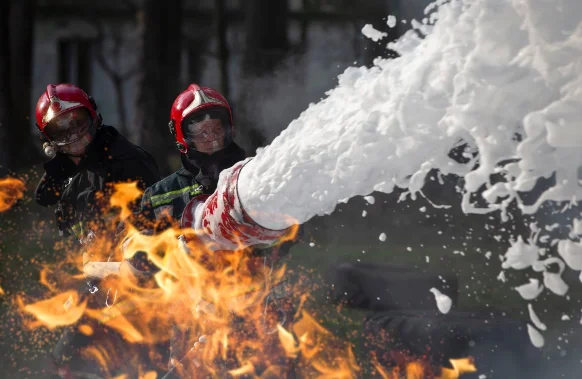In the perilous world of firefighting, heroes face a hidden menace: Aqueous Film-Forming Foam. Deployed against flammable liquid fires, AFFF harbors per- and poly-fluoroalkyl substances known for their lasting impact and suspected health risks, like cancer.
Firefighters are at a crossroads as legal actions multiply against AFFF makers for alleged negligence in risk disclosure. In this article, we challenge firefighting standards and demand immediate reforms to ensure firefighter safety and regulatory accountability.
Understanding AFFF and Its Chemical Components
AFFF contains per- and polyfluoroalkyl substances (PFAS) designed to suppress flammable liquid fires effectively. However, PFAS are persistent chemicals associated with various health risks, including cancer. Known for their ability to accumulate in the environment and resist degradation, PFAS pose long-term threats to human health and ecosystems alike.
An NIH investigation focuses on the long-term impacts of firefighting foam on groundwater at a Cape Cod military base. Analyzing decades of data, they found that a significant portion of these chemicals can transform into more hazardous substances, persistently contaminating groundwater. This underscores the critical need to understand AFFF’s composition to mitigate environmental risks effectively.
This has spurred calls for safer firefighting alternatives and stricter regulations to safeguard firefighters and the broader community from potential harm.
Health Risks and Cancer Concerns
Exposure to per- and poly-fluoroalkyl substances (PFAS) found in AFFF has been linked to increased cancer rates among firefighting personnel. These chemicals are known for their ability to accumulate in the body and environment over time.
National Cancer Institute states studies linking PFAS exposure to increased cancer risks, such as testicular cancer among military personnel. Researchers studied 530 servicemen diagnosed with cancer during active duty and 530 cancer-free counterparts with pre-diagnostic blood samples.
The study linked higher levels of PFAS chemicals in the blood to firefighting or living near water contaminated with PFAS. They found a connection between high levels of a specific PFAS (PFOS) and an increased risk of testicular cancer.
Legal Actions and Lawsuits
Legal actions and lawsuits targeting Aqueous Film-Forming Foam highlight growing concerns regarding its impact on firefighter health. Allegations in these cases connect exposure to AFFF’s per- and poly-fluoroalkyl substances (PFAS) with heightened cancer risks among firefighters.
A firefighting foam lawsuit involves legal proceedings targeting Aqueous Film-Forming Foam (AFFF) manufacturers, alleging harm caused by chemicals such as PFAS. These cases aim to secure compensation for health problems like cancer and environmental harm.
Plaintiffs, often firefighters or affected communities, seek compensation for cancer and cleanup costs by filing lawsuits. Till June 2024, 8,270 lawsuits concerning AFFF were filed. By July, this number had increased to 9,198, according to TorHoerman Law.
As these lawsuits progress, they draw attention to regulatory gaps and advocate for stricter oversight of firefighting chemicals. The outcomes of these legal battles may significantly influence future safety standards, prompting the adoption of safer firefighting alternatives. Also, reform policies should be implemented to reduce health risks in firefighting operations.
Regulatory Response and Awareness
Legal battles involving Aqueous Film-Forming Foam (AFFF) have prompted heightened regulatory scrutiny and awareness of its potential health risks for firefighters. Regulatory agencies reassess safety rules for PFAS in firefighting chemicals amidst cancer concerns.
ALS states that global efforts are being made to regulate AFFF and PFAS to enforce environmental standards. Manufacturing and environmental management industries in the US and Europe expect more PFAS testing and rules to comply with. This shows how regulations are changing to tackle environmental and health problems linked to PFAS contamination.
Protective Measures and Future Outlook
Ensuring firefighters’ safety amid the cancer risks linked to AFFF demands rigorous protective measures. Future safety protocols should prioritize thorough decontamination post-exposure and upgraded personal protective gear (PPE).
Advancing research toward safer firefighting alternatives free from harmful substances like PFAS is crucial. As legal actions reshape industry norms, optimism grows for stricter regulations and heightened awareness to protect firefighter health.
EPA states new regulations for drinking water standards are aimed at reducing PFAS exposure and are projected to benefit by preventing illnesses and deaths. The accompanying funding initiative underscores efforts to implement PFAS testing and treatment, ensuring safer water systems and addressing contamination risks effectively.
Frequently Asked Questions
What health risks do firefighters face from exposure to AFFF chemicals?
Chemicals in AFFF have been connected to various health issues by researchers, the EPA, and the U.S. Department of Veterans Affairs. These problems include immune system changes, developmental alterations in fetuses and children, fertility complications, cholesterol disorders, and an elevated risk of testicular cancer. It also includes kidney and other cancers, liver damage, pregnancy-induced hypertension/preeclampsia, thyroid disease, and ulcerative colitis.
What legal actions are firefighters taking against AFFF manufacturers?
Legal actions by firefighters target AFFF manufacturers, alleging failure to disclose PFAS-related health risks. It aims to hold them accountable for increased cancer rates among firefighting personnel.
What regulatory measures address risks from AFFF chemicals?
Regulatory efforts prioritize revising safety standards for AFFF chemicals, potentially implementing bans or stricter PFAS controls. They are also advocating for enhanced transparency regarding chemical composition and associated health risks.
Safeguarding Firefighters
As legal actions against AFFF progress, the firefighting community grapples with critical issues of safety and accountability. These lawsuits underscore the pressing need for transparency in chemical safety as firefighters confront ongoing risks associated with per- and polyfluoroalkyl substances.
Beyond litigation, this pivotal moment calls for strengthened regulatory oversight and the exploration of innovative firefighting solutions. Prioritizing firefighter well-being and public safety is essential as stakeholders work towards safer practices and policies.

Robert Wiley is a versatile and accomplished writer with expertise spanning multiple niches, delivering insightful and engaging content across various fields. His diverse experience and deep knowledge make him a sought-after author in the world of digital writing.




